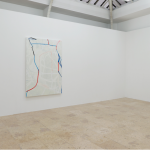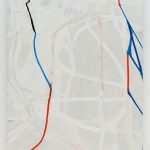Emil Michael Klein
Red, Blue and Black Lines
March 10 – April 24, 2017
Untitled
2016
Oil on canvas
187 x 120 cm
Untitled
2016
Oil on canvas
185 x 120 cm
- The exhibition “Red, Blue and Black Lines” by Swiss artist Emil Michael Klein consists of two paintings, similar in size and style, but distant in time.
- Both paintings emerge from Klein’s most recent explorations of the interplay between surface and background in painting. In the body of works to which the two paintings on show belong, Klein paints the canvas first in a dark—black or blue—ground. Then, he proceeds to erase large partitions of the ground with white paint, leaving exposed only thin rivulets of the underlying dark. From a distance, the resulting painting is a neutral field corrupted by a net of neurotic lines. On closer inspection, its bold stratification exposes instead a modus operandi that doesn’t lie in the idiosyncratic gesture of drawing a line, but rather in building a screen that progressively annihilates the painting. This process leaves no space for creative quirkiness, and even less for artistic freedom; it portrays the artist as an homo economicus who, facing the painting that he has just painted, asks himself how much of his creation should be saved for distribution in the world of images. His is not just a claim for an economy of artistic production, but also for responsibility in the continuous bastardization of historical artistic genres that often we call “innovation”.
- It is then important to note that the two paintings in the exhibition differ in the time of their execution, because Klein’s painting process is that of a sedimentation of layers, or of touches and gazes, through time. In the inevitable comparison of the two paintings, the viewer should put aside the analytical tools canonically affiliated with Abstractionism and based on the reading of formal composition and color scheme, and instead try to measure the layers of dust that lie on these paintings before they leave the artist’s studio—or better, the number of days the artist lived in close proximity with them, without being able to let them go. Eventually, she should ask herself: What is the reason for this hesitation?These painting might always be unfinished, but the fact that they are shown means that they’ve grown on the artist enough. It’s a matter of making consensus between the artist and the paintings come before that of the paintings and the viewer. In a way, these two paintings, as the lines they reveal, are the chosen ones.
- Michele D’Aurizio
- March 2017


